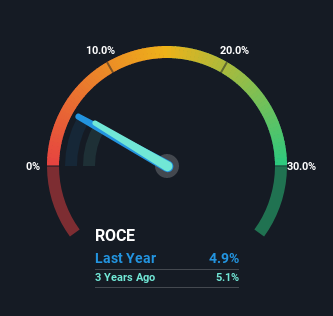Stock Analysis

Did you know there are some financial metrics that can provide clues of a potential multi-bagger? Typically, we'll want to notice a trend of growing return on capital employed (ROCE) and alongside that, an expanding base of capital employed. Ultimately, this demonstrates that it's a business that is reinvesting profits at increasing rates of return. Although, when we looked at Spire (NYSE:SR), it didn't seem to tick all of these boxes.
What Is Return On Capital Employed (ROCE)?
For those that aren't sure what ROCE is, it measures the amount of pre-tax profits a company can generate from the capital employed in its business. Analysts use this formula to calculate it for Spire:
Return on Capital Employed = Earnings Before Interest and Tax (EBIT) ÷ (Total Assets - Current Liabilities)
0.049 = US$390m ÷ (US$9.8b - US$1.7b) (Based on the trailing twelve months to June 2022).
Thus, Spire has an ROCE of 4.9%. Even though it's in line with the industry average of 5.4%, it's still a low return by itself.
Our analysis indicates that SR is potentially undervalued!

In the above chart we have measured Spire's prior ROCE against its prior performance, but the future is arguably more important. If you'd like to see what analysts are forecasting going forward, you should check out our free report for Spire.
How Are Returns Trending?
The returns on capital haven't changed much for Spire in recent years. The company has consistently earned 4.9% for the last five years, and the capital employed within the business has risen 49% in that time. Given the company has increased the amount of capital employed, it appears the investments that have been made simply don't provide a high return on capital.
The Bottom Line
Long story short, while Spire has been reinvesting its capital, the returns that it's generating haven't increased. And investors may be recognizing these trends since the stock has only returned a total of 0.8% to shareholders over the last five years. Therefore, if you're looking for a multi-bagger, we'd propose looking at other options.
Since virtually every company faces some risks, it's worth knowing what they are, and we've spotted 2 warning signs for Spire (of which 1 is a bit concerning!) that you should know about.
If you want to search for solid companies with great earnings, check out this free list of companies with good balance sheets and impressive returns on equity.
Valuation is complex, but we're helping make it simple.
Find out whether Spire is potentially over or undervalued by checking out our comprehensive analysis, which includes fair value estimates, risks and warnings, dividends, insider transactions and financial health.
View the Free AnalysisHave feedback on this article? Concerned about the content? Get in touch with us directly. Alternatively, email editorial-team (at) simplywallst.com.
This article by Simply Wall St is general in nature. We provide commentary based on historical data and analyst forecasts only using an unbiased methodology and our articles are not intended to be financial advice. It does not constitute a recommendation to buy or sell any stock, and does not take account of your objectives, or your financial situation. We aim to bring you long-term focused analysis driven by fundamental data. Note that our analysis may not factor in the latest price-sensitive company announcements or qualitative material. Simply Wall St has no position in any stocks mentioned.
About NYSE:SR
Spire
Engages in the purchase, retail distribution, and sale of natural gas to residential, commercial, industrial, and other end-users of natural gas in the United States.
Established dividend payer and slightly overvalued.

